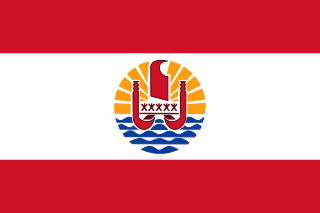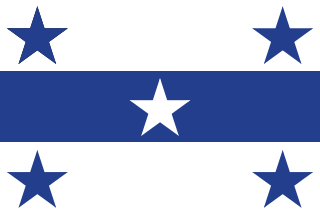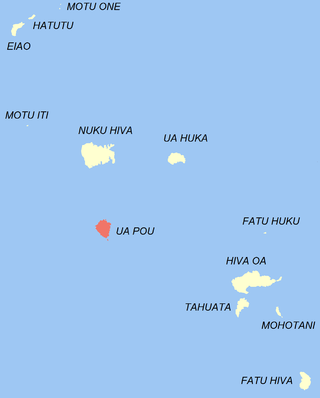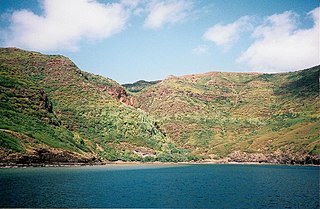
French Polynesia is an overseas collectivity of France and its sole overseas country. It comprises 121 geographically dispersed islands and atolls stretching over more than 2,000 kilometres (1,200 mi) in the South Pacific Ocean. The total land area of French Polynesia is 3,521 square kilometres (1,359 sq mi), with a population of 278,786 of which at least 205,000 live in the Society Islands and the remaining population lives in the rest of the archipelago.

The Marquesas Islands are a group of volcanic islands in French Polynesia, an overseas collectivity of France in the southern Pacific Ocean. Their highest point is the peak of Mount Oave on Ua Pou island, at 1,230 m (4,035 ft) above sea level.

Fatu-Hiva is the southernmost island of the Marquesas Islands in French Polynesia, an overseas territory of France in the Pacific Ocean. With Motu Nao as its closest neighbour, it is also the most isolated of the inhabited islands.
Marquesan is a collection of East-Central Polynesian dialects, of the Marquesic group, spoken in the Marquesas Islands of French Polynesia. They are usually classified into two groups, North Marquesan and South Marquesan, roughly along geographic lines.

The Gambier Islands are an archipelago in French Polynesia, located at the southeast terminus of the Tuamotu archipelago. They cover an area of 27.8 km2 or 10.7 sq mi, and are made up of the Mangareva Islands, a group of high islands remnants of a caldera along with islets on the surrounding fringing reef, and the uninhabited Temoe atoll, which is located 45 km south-east of the Mangareva Islands. The Gambiers are generally considered a separate island group from Tuamotu both because their culture and language (Mangarevan) are much more closely related to those of the Marquesas Islands, and because, while the Tuamotus comprise several chains of coral atolls, the Mangareva Islands are of volcanic origin with central high islands.

Mohotani is an uninhabited island southeast of Hiva Oa and east of Tahuata in the southern Marquesas Islands. It has an area of 15 km2. Much of the island's sparse vegetation has been destroyed by feral goats and sheep, to the extent that following its rare rains, the sea around it is stained red from runoff. Early reports describes the island as fertile, with forest and fields. When Thor Heyerdahl visited the island in 1938, there were only a few goats and remains of deserted huts and villages.

Motu One is the name of a small sandbank with no vegetation, located on the western edge of a coral reef; the only atoll in the Marquesas Islands.

Ua Pou is the third largest of the Marquesas Islands, in French Polynesia, an overseas territory of France in the Pacific Ocean.

Eiao is the largest of the extreme northwestern Marquesas Islands. The island is uninhabited, but is administratively part of the commune (municipality) of Nuku-Hiva, itself in the administrative subdivision of the Marquesas Islands.
The Motu One Reserve is a nature reserve encompassing the whole of the island and reef system of Motu One in the northern Marquesas Islands. The reserve was declared in 1992 in combination with several other reserves were declared as a part of the Marquesan Nature Reserves. This includes the Hatutu Nature Reserve, the Motane Nature Reserve, and the Eiao Island Nature Reserve.

The Marquesan Nature Reserves are a network of small nature reserves in the Marquesas Islands. The reserves were declared by the government of French Polynesia in 1992, as a first step toward preserving the native flora and fauna of some of the smaller islands of the group.
The Hatutu Nature Reserve is a nature reserve encompassing the whole of the island of Hatutu in the northern Marquesas Islands. The reserve was declared in 1971, and is the primary nesting site of several endangered species, several of which are endemic, including the Hatutu Marquesan warbler and the Marquesas ground dove. The Hatutu Nature Reserve is home to one of the most important nesting grounds for the blue-footed booby.
The Eiao Marquesan warbler is a subspecies of the northern Marquesan reed warbler found only in the dry upland forest on Eiao in the northern Marquesas Islands.

The Eiao Nature Reserve is a nature reserve encompassing the whole of the island of Eiao in the northern Marquesas Islands, as well as several surrounding rocks.

Tahuata is the smallest of the inhabited Marquesas Islands, in French Polynesia, an overseas territory of France in the Pacific Ocean. It is located 4 km (2.5 mi.) to the south of the western end of Hiva Oa, across the Canal du Bordelais, called Ha‘ava in Marquesan.

Vaituha is a small valley in northwestern Eiao in which a small watersource empties into a small bay of the same name. This bay is one of two reliable anchorages on Eiao. The depth of the bay is 27 meters.

Ua Huka is one of the Marquesas Islands, in French Polynesia, an overseas territory of France in the Pacific Ocean. It is situated in the northern group of the archipelago, approximately 25 mi (40 km) to the east of Nuku Hiva, at 8°54′S139°33′W.

Nuku-Hiva is a commune of French Polynesia, an overseas territory of France in the Pacific Ocean. The commune is in the administrative subdivision of the Marquesas Islands. Its population was 3,025 at the 2022 census.

Hiva-Oa is a commune of French Polynesia, an overseas territory of France in the Pacific Ocean. The commune is in the administrative subdivision of the Marquesas Islands. Its population was 2,371 at the 2022 census.

Nuku Hiva is the largest of the Marquesas Islands in French Polynesia, an overseas country of France in the Pacific Ocean. It was formerly also known as Île Marchand and Madison Island.















